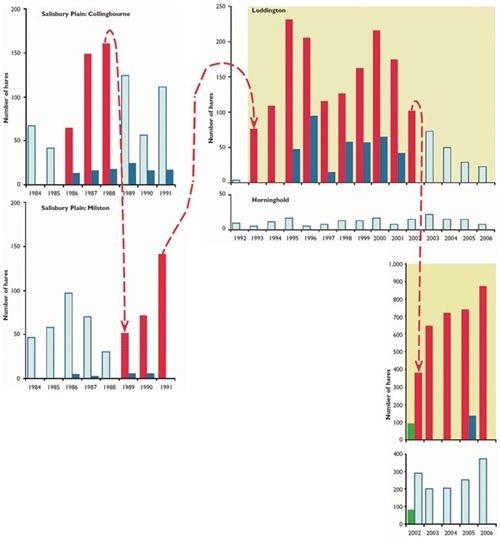Key findings
- The onset of predator control was always accompanied by increases in hare numbers.
- Predator control explained 46% of the variation in hare population change.
- Where habitat is improved, predators can stop hare numbers responding fully to it.
Since 1985, a sequence of three studies by us has considered the impacts of predator control on small game species including grey partridge, pheasant, and brown hare. These studies (Salisbury Plain, Loddington and Royston) have been carried out by the same gamekeeper, Malcolm Brockless, who moved from one to the next.
The studies had different purposes. Only Salisbury Plain (1985-91) was a formal scientific experiment in which ‘predator control’ was compared with ‘no predator control’ both spatially and sequentially. Loddington (started 1993) and Royston (started 2002) are demonstrations of game and wildlife management, with limited scope for experimental design, but both had areas nearby that could be monitored for comparison. At Loddington, predator control was stopped in 2002 deliberately to create a sequential comparison. Throughout all three studies, hare density was monitored by annual winter spotlight counts.
The sequence of events and associated trends in brown hare numbers are shown in Figure 1 overleaf. In each study, the onset of predator control corresponded with increasing hare numbers, whereas on comparison areas, hare numbers declined or remained stable. On Salisbury Plain, predator control was limited to three years, and no habitat improvement took place.
At Loddington and Royston, habitat improvements and longer periods of predator control led to brown hare densities (respectively up to 78 and 87 hares per 100 hectares) that would be considered exceptional anywhere in Britain. At Loddington, the hare population also supported substantial winter shoots (up to 30 per 100 hectares) without decline. When both shooting and predator control ceased there in 2002, hare density collapsed even though habitat improvements remained in place. Simultaneously, as predator control and habitat improvement began at Royston, hare numbers there began to build rapidly.
Given that this sequence of studies was not designed specifically to determine the impact of predator control on hare numbers, it is important that this interpretation is supported by statistical analysis. After all, hare populations are also heavily influenced by weather, parasites, and potentially by other farming-related factors. We must be convinced that the trends in hare numbers really were related to predator control and not to coincidental effects of site and year.
Across all three studies, regression modelling of the proportional change in hare numbers between successive years showed that, after site and year differences and shooting were accounted for, predator control was indeed a significant determinant of population change, explaining 46% of the variation in it.
There has been a good deal of debate about the relative importance of predation and habitat quality for brown hares in modern European landscapes. On reviewing available evidence (little of it experimental or involving predator control) other scientists have concluded that habitat was ultimately the driving factor behind 20th century declines experienced throughout Europe.
Our studies are valuable in that they illustrate the effects of manipulating predator density and habitat, both separately and together. Although habitat improvement or predator control alone supported relatively modest increases in hare density, together these factors were super-additive. The implication is that where habitat is improved, predators can prevent hares from increasing to take full advantage of it. In a commercially-driven agricultural landscape, the extent to which habitat can be improved is limited. Suppression of predator numbers well below their typical densities is probably necessary to allow an abundance of hares.
Figure 1: Hare numbers in relation to the presence of predator control and habitat improvement

Across three long-term studies (opposite and this page), hare densities increased wherever predator control was implemented (red bars and arrows), in comparison to sites and years without predator control (pale blue bars). In each study, starting hare density was similar on the two areas surveyed (indicated by spring counts in 2002 at Royston). The most dramatic increases occurred at Loddington and Royston where habitat improvements were also made, but improved habitat alone was insufficient to maintain hare density at Loddington after 2002 when predator control was transferred to Royston. Substantial bags of up to 30 hares per 100 hectares (dark blue bars) were also made from hare populations while at high density.